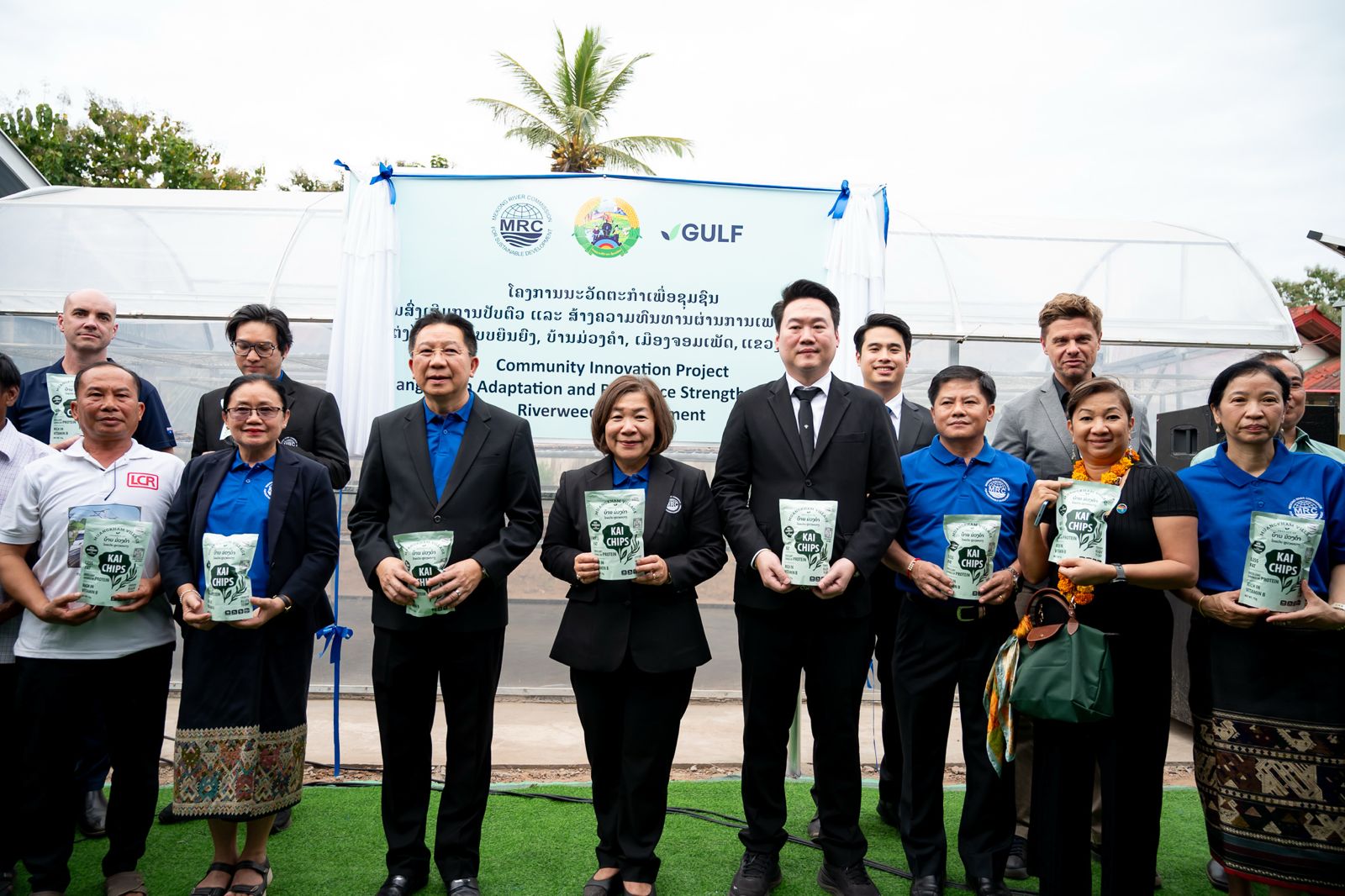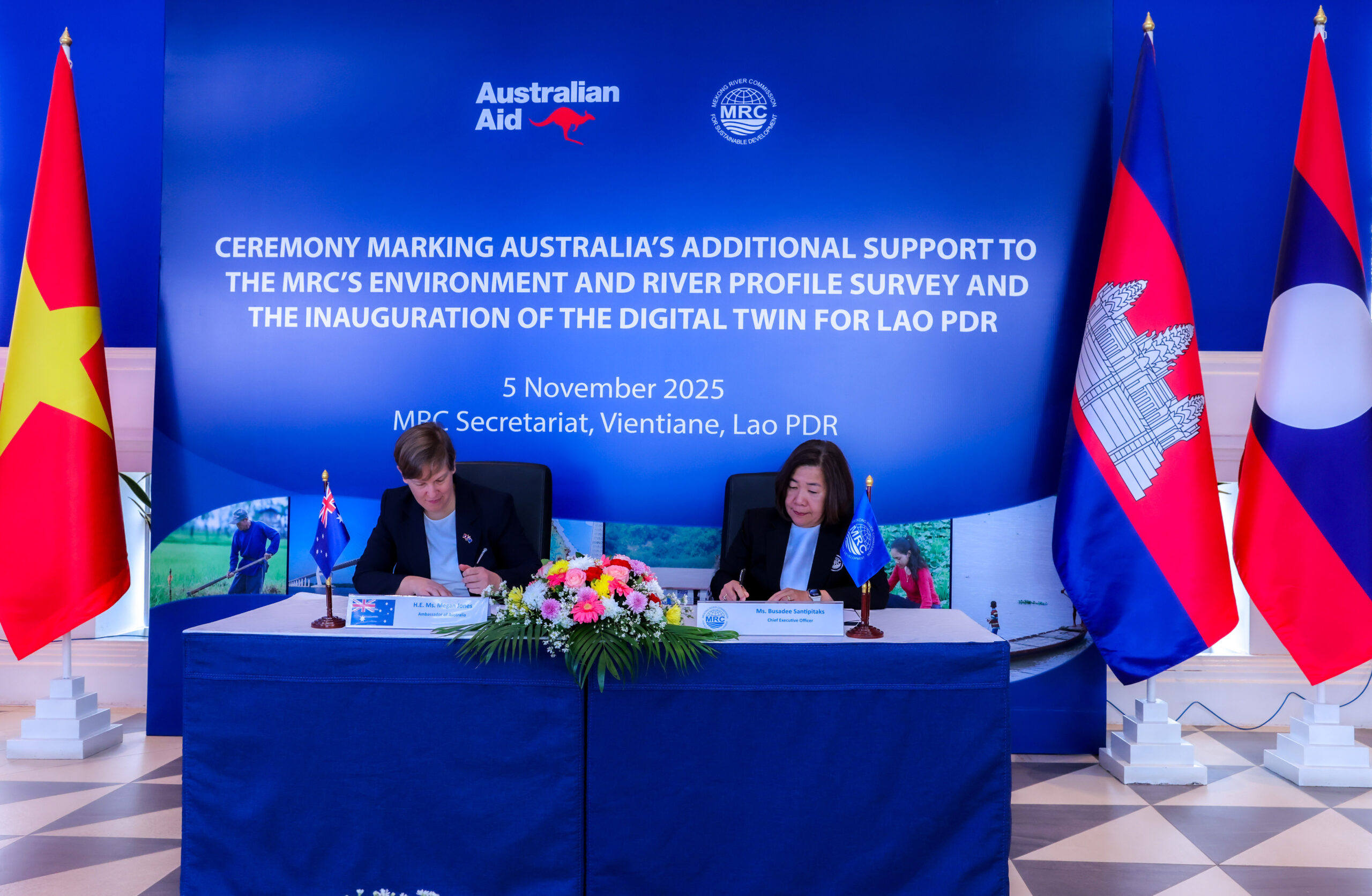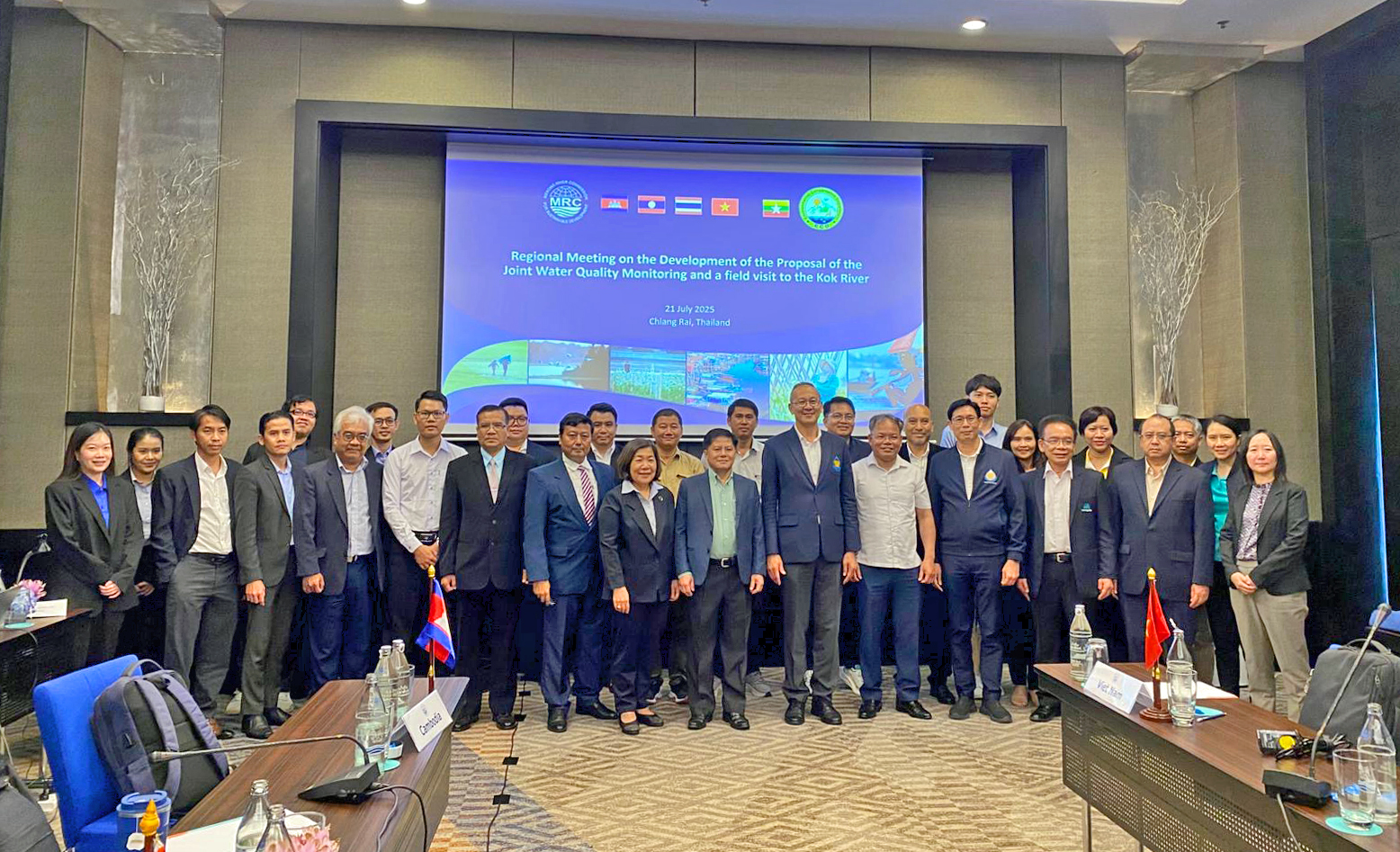The 4th State of the Mekong Address by Ms Busadee Santipitaks, CEO of the Mekong River Commission Secretariat 24 April 2025

- Your Excellency Dr. Surasri Kittimonton, Honored Guest and Designated Representative of the Chairperson of the MRC Council for 2025, Secretary-General of the Office of the National Water Resources, Member of the MRC Joint Committee for Thailand,
- Your Excellency Chanthanet Boualapha, Vice-Minister of Natural Resources and Environment and Alternate Member of the MRC Council for Lao PDR,
- Excellencies, Distinguished Guests, Ladies and Gentlemen, Mekong friends,
As the 4th Riparian CEO who took office over 2 months ago, I am deeply honoured to be with all of you today to celebrate a significant milestone for the Mekong River Commission – the 30th anniversary of the signing of the Agreement on the Cooperation for the Sustainable Development of the Mekong River Basin or widely known as the 1995 Mekong Agreement.
The Mekong belongs to all of us, and I hope that today will give you another chance to reflect on what the Mekong means for you, your work, your community. And more importantly for our shared future.
Last year, the MRCS released the 2023 State of the Basin Report and the Mekong Atlas which have shown that the Mekong region has undergone notable evolution over the past decades. While there have been areas of positive developments, there remain some areas that will require careful consideration and collaborative action.
Let me highlight the immense value our water-related sectors have brought to the basin’s economy, generating nearly $63 billion annually. Key sectors like rice, fisheries, and hydropower contribute immensely to the national economies, especially in the four lower Mekong countries. The combined GDP in the Lower Mekong River Basin related to energy, fisheries, agriculture, and navigation is estimated at $133.7 billion.
Socially, over the past two decades, living conditions in the Lower Mekong River Basin have improved significantly. More households now have access to clean water, sanitation, and electricity. Water-borne or related diseases have declined; food security has improved, with more people gaining access to nutritious food and malnutrition rates decreasing.
However, there are gaps that still need to be filled and more work to be done.
We must continue to join hands, protect and preserve our shared river.
But time is not on our side and the choices we make together will shape the future of this great river for the millions whose lives depend on it.
Excellencies, Distinguished Guests, Ladies and Gentlemen,
We cannot overlook climate change.
Over the past 50 years, temperatures in the Mekong region have risen by 1.4 degrees Celsius. We are seeing more extreme heat, erratic rainfall, and rising sea levels along Vietnam’s coast, which is increasing salinity in the farmlands. Recently, reduced reverse flow to Tonle Sap has been experienced, the Mekong Delta has faced intensifying saltwater intrusion amid declining dry season flow.
Sediment transport has also declined, leading to more riverbank erosion. The health of our wetlands is still a concern. The decline in mangrove forests in the Mekong Delta, down by nearly 30% in just a decade, puts coastal communities at greater risk from rising sea levels and storm surges.
While we may appreciate some good news that water quality is still largely good – meeting health and agricultural standards, La Niña may bring hotter temperatures and less rain, increasing drought risks in 2025. Not to mention that the rising temperatures in the river also affect fish populations and aquatic ecosystems.
Last year, we faced Typhoon Yagi that caused historical floods in the mainstream in Chiang Khan, Vientiane, Nongkhai, and Nakhon Panom. Indeed, it was a wake-up call for us that despite the concerted efforts, effective coordination and forecasting systems, the severity and the unpredictable weather patterns continue to challenge us.
Basin countries recognise the urgency of climate adaption, but financing gaps and institutional challenges remain. Increased efforts are needed to strengthen disaster preparedness, particularly at the community level. Downstream areas also face the greatest environmental challenges, from sediment to wetland degradation to increased salinity. Sandmining and plastic pollution are ongoing concerns.
Excellencies, Distinguished Guests, Ladies and Gentlemen,
The 1995 Mekong Agreement created the MRC as an agreement-based organization. Unlike many transboundary rivers where competition leads to conflict, the lower Mekong countries are guided by a framework that prioritises cooperation over confrontation. The agreement is based on key principles: each country has the right to develop its water resources, but not at the expense of its neighbours; water use should be fair and balanced; projects should not cause significant harm; and major developments must go through consultation.
These principles have helped to preserve peace and maintain regional stability, but they also raise challenges. Some may say that the 1995 Mekong Agreement lax enforcement, but we must acknowledge that this agreement allows us to cooperate better. Over the years, the Agreement has guided our commitment to manage this river together, based on science, fairness, mutual respect and compromise. At the 4th MRC Summit in 2023, our leaders stood together and reaffirmed their commitment. We certainly expect to see the same spirit of commitment at the 5th MRC Summit in 2026.
The MRC has played a key role in monitoring river conditions, assessing impacts, and facilitating regional discussions. Alongside consultations, we know that we need stronger implementation of agreements, more engagement with local stakeholders, and deeper cooperation with upstream countries like China. We also need to find a balance between economic growth and sustainability, making sure development projects do not compromise the health of the river or the well-being of the people whose livelihoods depend on it.
Each country brings different strengths, priorities, and needs to the table. So, when we collaborate, we all win. The past decades have shown that collaboration delivers results, and we must build on that momentum. The Mekong Agreement remains our best tool for cooperation, and its success depends on us. In this regard, the MRCS will continue to strengthen its technical expertise and provide its professional support to the member countries.
I am a positive thinker. I believe in a future where we must work more closely together, embrace new ideas, and ensure that everyone has a voice in shaping the Mekong’s future.
As the MRC wraps up the current Strategic Plan 2021-2025 at the end of this year, it is timely for us to reflect on our accomplishments and set a bold direction for the next five years 2026-2030, and in line with the Basin Development Strategy 2021-2030. Our strategic direction will focus on intensifying cooperation, innovation, and inclusivity. This will also entail having adequate resources for the sustainability of the organisation to deliver its priorities and tasks of ensuring the sustainable development and management of the Mekong River.
First, cooperation. Water knows no borders, and our commitment to managing it wisely must not falter. The challenges we face – floods, droughts, climate change, sustainable development – are too big for any one country, organization, or sector to tackle alone. We therefore need to deepen partnerships – not just within the Mekong region, but with our Mekong friends globally.
Our collaboration with the Development Partners is long-standing and will be as valuable as ever before. We must continue to work together proactively amidst the challenging global uncertainties that we face together. The engagement with other partnerships is also important for us to keep up with more options to make better decisions.
In addition, the MRC and the Lancang-Mekong Cooperation have worked together. Through joint studies, expert working groups, and real-time data sharing, we have been working together to put the studies into practices. When severe floods hit last September, we coordinated, we shared information, in a way that we can help communities prepare.
We also focused on the Proactive Regional Planning initiative, which has already identified joint projects in agriculture, floods and droughts, and hydropower initiatives. These are steps in the right direction, and we must build on it with advanced tools.
Regionally, the Mekong isn’t just important to the four lower basin countries, but it contributes immensely to ASEAN’s shared prosperity. The 2nd ASEAN-MRC Water Security Dialogue held last year has shown that the Mekong’s future is a regional priority. Indonesia has already stepped up as a partner. Singapore and others are showing keen interest because the Mekong’s future is vital to Southeast Asia – food, energy, and climate resilience. We aim to explore the opportunity to connect the MRC Summit with the ASEAN Summit every two years to strengthen and increase the frequency of the leadership engagement to tackle emerging Mekong issues.
The complexity of transboundary impacts of the Mekong is not isolated. Water security is a challenge faced by river basins across the world. We must share our views and learn from others – from the Itaipu hydropower cooperation between Brazil and Paraguay, from Europe’s transboundary water agreements, other river basins, and from successful climate adaptation programs in Africa and North America.
I believe the MRC can play a bigger role in connecting global expertise to local realities, ensuring that our solutions are based on knowledge of the best practices from around the world.
Second, innovation. climate change is hitting us harder and faster than ever before. And we need to be proactive.
Technology offers us game-changing solutions. Artificial intelligence and satellite technology are already transforming how we predict and prepare for extreme weather events. Imagine if we could forecast a flood not just days, but weeks in advance – giving communities the time to protect their homes, businesses, and livelihoods. This is where we’re headed.
Our One Mekong App will continue to evolve, in the national languages, providing real-time updates and early warning. Flood and Drought TV will expand its reach, making sure that even the most remote villages have access to critical updates. And our river monitoring systems will become even more sophisticated, delivering actionable insights that can support us to make better decisions.
Policy innovation is just as important. We need to rethink how we govern water resources, ensuring that sustainability, equity, and long-term resilience guide every decision. And we’re thinking beyond offices. We are bringing the Mekong closer to the people. The new MRC Education and Visitor Center, inaugurated by the Prime Minister of Lao PDR in December last year, serves as an innovative knowledge hub for researchers, academia, policy makers, media, youth, and the public to take part in the future of the Mekong.
Third, inclusivity. We must listen to the voices that matter most – from the Mekong people who live along its banks. At this year’s 15th Regional Stakeholder Forum, we will bring more community members, farmers, fishers, and local leaders into the conversation. Their insights, concerns, and ideas will be valuable inputs for our policies and projects. Because at the end of the day, what we do is not just about water – it is about the people. And we must leave no one behind, especially mainstreaming gender equality in our work.
Excellencies, Distinguished Guests, Ladies and Gentlemen,
So, where do we go from here? We will build on what we have started. We must strengthen our regional and global partnerships. We will invest in technology and innovation. We should listen to the people who rely on the Mekong every day. And we must embrace the One Mekong spirit and live the mindset of Meeting the Needs, Keeping the Balance.
Let us work together towards:
- Better forecasting and emergency and disaster response: Stronger collaboration between the MRC Secretariat, Development Partners and Lancang Mekong Cooperation, national agencies, and private sector. Strengthening data sharing including operational data from infrastructures and improving forecasting and early warning systems, can help us save lives and protect livelihoods.
- More joint development projects: Mekong countries can jointly develop water resources together. We can create cross-border joint projects based on other regional examples.
- Stronger funding for community resilience: We’re putting the Mekong Fund to work. We are getting support from other global sources such as the Global Environment Facility transboundary fisheries project and we are working with Thailand Institute of Scientific and Technological Research. This way, we can empower communities to adapt and flourish. We will do more.
Excellencies, Distinguished Guests, and Mekong friends.
The 1995 Mekong Agreement proved that when we come together with a shared vision and joint commitment, we can achieve remarkable things. We must take that spirit even further – beyond borders, beyond politics, and beyond short-term thinking and planning.
Let’s make it happen – to fulfil that shared vision for the Mekong River Basin that is economically prosperous, socially just, environmentally sound, and climate resilient.
Thank you.
Happy Mekong Day.










